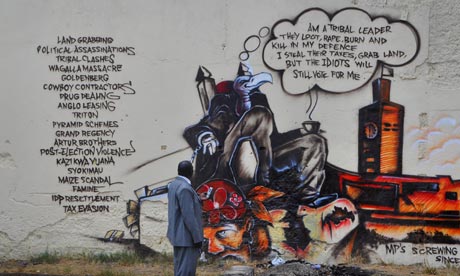Click here to learn more about Africa and its current events.
Lately, there has been a wide amount of coverage in the media concerning Africa and its numerous problems, from the Somali Pirates, to Darfur, to Joseph Kony and the film "Invisible Children", and to the coup d'etat in Guinea Bissau earlier this month. With so much affecting Africa, it is impossible to cover every region's distinct problems and its political art. But due to its alienation from the Western world through language barriers, and societal distancing it is among the most foreign areas out of the entire world. It is difficult to fully understand many of its unique cultures and social differences. It has been equally difficult to come across many artists working in politically themed art due to the censoring of those authoritarian governments. Here are only a few examples of such artists and their work.
Currently there is uproar in Kenya concerning a group of anonymous graffiti artists, headed by internationally acclaimed photojournalist, Boniface Mwangi. The group mostly remains anonymous due to the governments' notoriety of arresting and beating people who have contrasting views with governmental policies. The groups' work highly criticizes the corrupt members of Kenyan Parliament and hopes to awaken a change within people during the upcoming elections. Their notorious imagery consists of a caricature vulture dressed in a suit, representing members of the Kenyan Parliament, within various contexts, such as sitting on the $2,400 chairs found within the chamber of parliament. The graffiti art is serving as place to release the citizens' anger concerning the hefty salaries, tax exemptions for members of parliament, and their implementation of high taxes on the people. Most Kenyans agree with these messages but are afraid to show their displeasure with the current government. The anonymous group hopes that these murals will help people know they are not alone in their discontent. Meanwhile the government's reaction has brought the needed attention for international media to get interested with this type of artwork, usually covering up the walls within hours of their discoveries.
Click here to learn more about this.
 |
| Photo still of a wall with graffiti in Nairobi, Kenya |
Watch the following video from Kenya's 'The Headliner' to watch the team in action, how the local people are reacting, and how quickly the government censors their work around Nairobi, Kenya.
A more well-known contemporary artist is El Anatsui. Born in Ghana, his sculptural work references the colonial period and current post-colonial time in Africa by using traditional sculpting materials (metal, ceramic, and wood) and cast-off materials from Western world products, such as the metal caps of liquor bottles. His work consists of flexible sculptural pieces, usually in the form of a textile, . These pieces are installed in galleries and museums world-wide without any set of instructions, giving the curators the ability to give their own unique twist on the same piece that has traveled the world many times, continuously changing its look. El Anatsui describes his work as being physically about change; using destruction as a prerequisite for new ideas. He also points out that it is representative of conflict; both man-made conflict and conflicts with nature. His work is composed physically of objects used by man and discarded, which he transforms into something contemplative, absent of utility.
 |
| El Anatsui with one of his sculptural pieces |
Watch this video from PBS's Art21 series. Not only does it include commentary from El Anatsui, but it documents the creation process in Nigeria where his workshop is based, the installation process at a museum, and a look at other sculptural pieces of his creation.

No comments:
Post a Comment